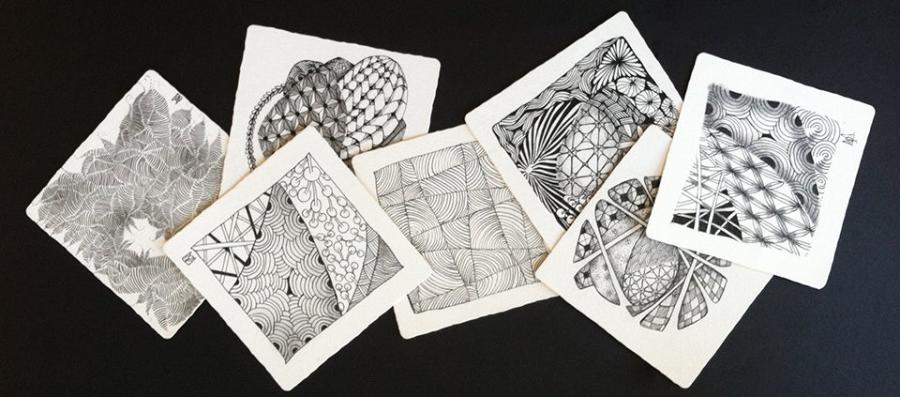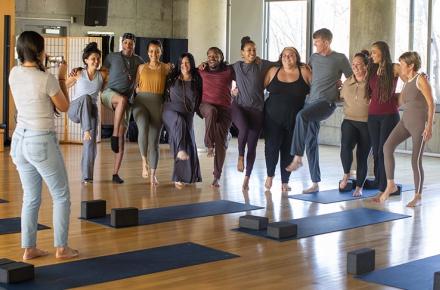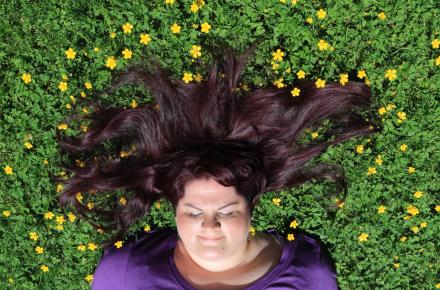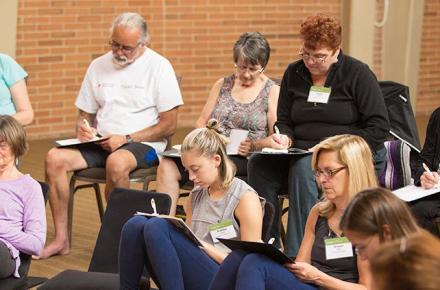Drawing Outside (and Inside) the Box: The Joy of Zentangle


As a child, I’d sometimes attend art classes on Saturdays. I don’t remember much about the classes, but I remember that I’d bring along drawings from different children’s books and try to replicate them. With my pencil, I’d painstakingly work to get the size of a young girl’s head just right, or I’d erase and redraw my sketch of a house to get it in correct proportion to my sketch of a nearby tree.
Drawing was fun, but my intention, even at that young age, was to make my drawings flawless and beautiful. I wasn’t the type to color outside the lines, and I wasn’t the type to create free-form images. Perfection was key.
My need to make art “just so” continues, to this day, to deter me from even picking up a crayon. Enter the Zentangle Method.
“When you sit down to draw with a pen and know that each mark you put down is meant to be, you draw with a sense of purpose and acceptance,” says Molly Hollibaugh, product developer for the Zentangle Method, a certified Zentangle teacher, and one of my Kripalu Perspectives guests. The Zentangle Method is an easy-to-learn way of creating beautiful non-representational images by drawing structured patterns. (Molly’s mother, Maria Thomas, and her husband, Rick Roberts, are the founders of Zentangle).
“Creating with the Zentangle Method has a specific ceremony,” says Martha Huggins, Molly’s sister, events director for the Zentangle Method and a certified Zentangle teacher who joined us for the podcast. “It’s this process of drawing repetitive patterns that have been deconstructed into simple strokes that allows you to let go of any planning. You have to focus your attention only on the line you’re drawing and not on what the end result might be.”
A great tool for stress relief and building present-moment awareness, Zentangle art is created with ink pens and pencil on a “tile,” a 3 ½-inch square piece of fine art paper. You can spend 15 minutes on a Zentangle creation, or take as long as you want. Creating one is comprised of eight steps:
- Express gratitude and appreciation for your materials and your time.
- Make four dots in the corners of your tile with a pencil.
- Draw a line connecting those dots to create a border.
- Draw another line, called a string, within the border that divides the space into sections.
- Draw repeating patterns, called tangles, within the different sections of your tile.
- Shade your drawing with a pencil.
- Initial and sign your work.
- Appreciate the art you’ve created.
Erasers aren’t used when practicing Zentangle, and there’s a reason for that. “We often say there are no erasers in life,” Molly notes. “Sometimes that unintended stroke or event is the very thing that leads to something wonderful. With an eraser in hand, you may always be in search of the perfect line or perfect composition, but never find it. We let go of that search for perfection and become comfortable with the journey. We start to see the beauty in every mark we make.”
One afternoon, I sat outdoors and created Zentangle art. I drew zigzags and curlicues within the sections of my tile, and I noticed something after a little while: I felt calmer. My breathing had slowed down; my mind had stopped racing, as it does when I practice yoga. The Zentangle Method has been called “yoga with a pen” because it’s made up of a sequence of steps that guides practitioners through a flow of creativity as they move from one tangle and transition to the next. “It’s the elegance of those limits that allows you to relax,” says Martha. “The border and the string create a safe structure for your practice—much like your practice on the mat. The tangles are your poses.”
Molly and Martha say they’ve witnessed the Zentangle Method make a positive difference in the lives of people suffering from stress, anxiety, depression, chronic pain, PTSD, the loss of a loved one, insecurity, and lack of motivation. “We’ve found that people who practice Zentangle regularly become more confident, excited, and mindful,” says Molly.
After practicing Zentangle over time, you begin to look at what life hands you from a new perspective, says Martha. “Since there’s no perceived outcome for what you’re creating, you learn to let go of expectations and embrace the process,” she explains. “If things don’t turn out as planned and there’s no ‘eraser’ to change what’s been done, you come up with a plan B and trust that the outcome will be wonderful.”
For perfectionists like me, the Zentangle Method encourages the appreciation of life’s happy accidents. It’s encouraging to look at my Zentangle creations. Imperfect as they are, they still turned out beautifully. Realizing that, I can relax and see the beauty in my equally imperfect life.














































